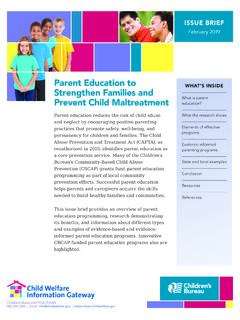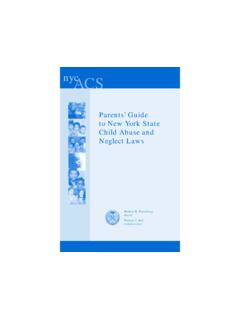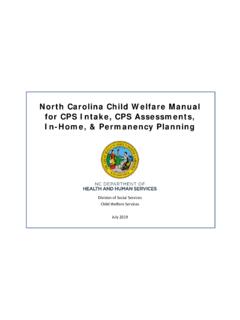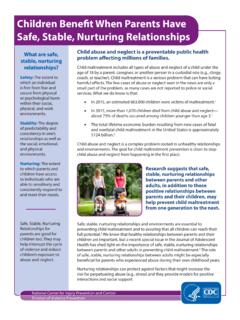Transcription of Treatment for Abused and Neglected ... - Child Welfare
1 Treatment for Abused and Neglected Children: Infancy to Age 18 Anthony J. Urquiza Cynthia Winn Department of Health and Human Services Administration for Children and Families Administration on Children, Youth and Families National Center on Child Abuse and Neglect This manual was developed and produced by Circle Solutions, Inc., McLean, VA, under subcontract No. HHS 105-89-1730 with Westover Consultants, Inc. This Page is intentionally left blankTABLE OF CONTENTS Page ATTRIBUTION i PREFACE iii ACKNOWLEDGMENTS v INTRODUCTION 1 Child DEVELOPMENT AND PSYCHOPATHOLOGY 3 Categories of Development 3 Intrapersonal Development 3 Interpersonal Development 4 Physical Development 6 Sexual Development 7 Behavioral Conduct 9 Developmental Psychopathology 11 CONSEQUENCES OF ABUSE AND NEGLECT 13 Physical Abuse 13 Consequences Within the Intrapersonal Category 13 Consequences Within the Interpersonal
2 Category 16 Consequences Within the Physical Category 16 Consequences Within the Sexual Category 17 Consequences Within the Behavioral Conduct Category 17 Child Sexual Abuse 18 Consequences Within the Intrapersonal Category 18 Consequences Within the Interpersonal Category 18 Consequences Within the Physical Category 18 Consequences Within the Sexual Category 19 Consequences Within the Behavioral Conduct Category 19 Child Neglect 20 Consequences Within the Intrapersonal Category 20 Consequences Within the Interpersonal Category 21 Consequences Within the Physical Category 21 Consequences Within the Sexual Category 22 Consequences Within the Behavioral Conduct Category 22 ASSESSMENT OF Child maltreatment 23 Assessment of the Child Within the Context of His/Her Environment 23 Issues To Be Considered in Assessment 24 Ethnicity and Socioeconomic Status 25 Social Desirability and Reporting Bias 26 Professional Roles in the Assessment Process 26 Use of Standardized
3 Measures 27 Multiaxial Assessment 27 Assessment Information from Children 27 Behavioral Report and/or Observation 28 Casual Observations 28 Projective Assessments 28 Projective Drawings 29 Projective Storytelling/Apperception Tests 29 Rorschach 29 Cognitive Assessments 30 Bayley Scales of Infant Development (BSID) 30 Wechsler Series of Intelligence Tests for Children 31 Kaufman Assessment Battery for Children (K-ABC) 31 Clinical Interviews 31 Nondirective Play Sessions 31 Structured Psychiatric Diagnostic Interviews 32 Assessment Information from Parents 33 The Child Behavior Checklist (CBCL) 33 The Vineland Adaptive Behavior Scales (VABS)
4 33 Family Assessment 33 The Purpose/Intent of Family Assessment 34 Standardized Measures of Family Assessment 34 Clinical Interviews 35 Supplemental Information 35 Teachers/School Personnel 36 Child Behavior Checklist Teacher Report Form 36 Child Welfare Caseworkers 36 Foster Parents/Supplemental Caretakers 36 Assessing Risk of Harm to Self and/or Others 37 Suicide 37 Self-Destructive Behavior 37 Danger to Others 38 Revictimization 38 THERAPY 39 Theoretical Orientations 39 Role of the Therapist 40 Clients Rights in Therapy 41 Abuse-Free Environment 41 Protection and Limit-Setting 42 Terminology and Communication 42 Information 43 Helpful Interventions 43 Individuality 43 Therapist Responsibilities 44 Confidentiality 44 Release of Information 45 Clarification of Fees and Services 45 Evaluation of Progress 46 The Therapeutic Relationship 46 Trust 46 Safety 46 Physical Safety 46 Emotional Safety 47 Resistance 49 Organization and Structure of Sessions 50
5 Format 50 Use of Time 50 Content 51 Process 52 Stages of Therapy 52 Intake Phase 52 Determining the Child s Need for Treatment 52 Taking a History 53 Developing a Treatment Plan 54 Determining the Prognosis 54 Beginning Phase 56 Middle Phase 56 Accessing the Abuse Memories 57 Sensations 57 Thoughts and Feelings 57 Beliefs 58 Termination Phase 59 Long-Term Issues 60 Treatment Modalities 60 Primary Prevention Programs 61 Play Therapy 61 Individual Therapy 61 Group Therapy 62 Family Therapy 62 Summary 62 Treatment ISSUES FOR Abused AND Neglected CHILDREN AND SPECIALIZED INTERVENTIONS 63 Physical Health Concerns 63 Sexually Transmitted Diseases and Fear of Acquired Immunodeficiency Syndrome (AIDS)
6 63 Sexual and Physical Adequacy 63 Pregnancy 64 Scarring and Permanent Damage 65 Encopresis and Enuresis 65 Psychosomatic Complaints 66 Developmental Issues 67 Attachment 67 Mastery and Control 68 Impulse Control 69 Identity 70 Interpersonal Issues 70 Identification With the Aggressor 70 Victimizing Behaviors 71 Intimacy 71 Betrayal 72 Intrapersonal Issues 73 Fear 73 Trauma 73 Anxiety 74 Depression 75 Lack of Expression of Feelings 75 Guilt, Blame, and Responsibility 76 Loss and Grief 78 Self-Worth, Self-Esteem.
7 Self-Efficacy 79 Stigmatization/Damaged Goods 80 Learned Helplessness 80 Behavioral Issues 82 Avoidant Behavior 82 Dependent Behavior 83 Aggressive Behavior 84 Hypersexual Behavior 85 Suggestive Sexual Behavior 85 Masturbation 86 Summary 86 CASE MANAGEMENT 89 Family Members 89 Parents 89 Siblings 89 Relatives 90 School 91 Teacher 91 School Counselor 91 School Psychologist 92 Child Welfare Agencies 92 Juvenile Court 92 Substitute Care Placement 92 Visitation 93 Reunification 93 Law Enforcement 93 Prosecution 94 Conclusion 95 NOTES 97 GLOSSARY OF TERMS 111 SELECTED BIBLIOGRAPHY 117 OTHER RESOURCES 119 LIST OF TABLES AND FIGURES FIGURE 1.
8 The Ecology of Human Development 14 TABLE 1. Determinants of Abuse: Compensatory and Risk Behaviors 15 ATTRIBUTION The Department of Health and Human Services acknowledges the contribution of Harold P. Martin, who was the author of Treatment of Abused and Neglected Children, August 1979 and Bruce Fisher, Jane Berdie, Jo Ann Cook, and Noel Day, who were the authors of Adolescent Abuse and Neglect: Intervention Strategies, January 1980. i ii This Page is intentionally left blank PREFACE The Child Abuse Prevention and Treatment Act was signed into law in 1974.
9 Since that time, the Federal Government has served as a catalyst to mobilize society s social service, mental health, medical, educational, legal, and law enforcement resources to address the challenges in the prevention and Treatment of Child abuse and neglect. In 1977, in one of its early efforts to achieve this goal, the National Center on Child Abuse and Neglect (NCCAN) developed 21 manuals (the User Manual Series) to provide guidance to professionals involved in the Child protection system and to enhance community collaboration and the quality of services provided to children and families.
10 Some manuals described professional roles and responsibilities in the prevention, identification, and Treatment of Child maltreatment . Other manuals in the series addressed special topics, for example, adolescent abuse and neglect. Our understanding of the complex problems of Child abuse and neglect has increased dramatically since the user manuals were developed. This increased knowledge has improved our ability to intervene effectively in the lives of troubled families. Likewise, we have a better grasp of what we can do to prevent Child abuse and neglect from occurring.















